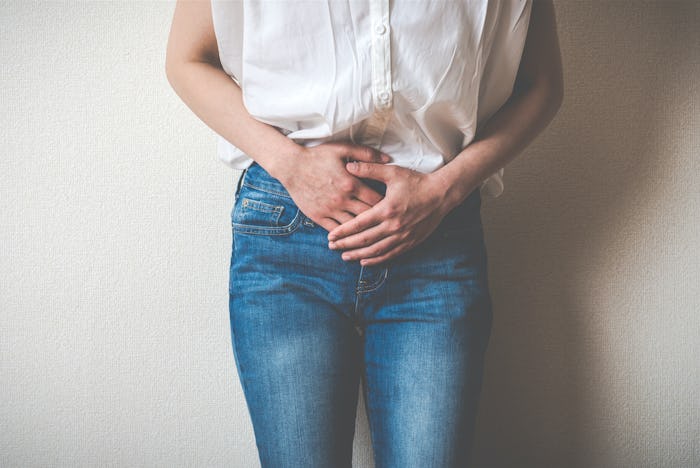Pregnancy changes a lot of things, including the way your body functions. Heartburn, nausea, and general discomfort become part of your daily life, albeit temporarily. And while you may look forward to the day your baby is born and your body "snaps back" to its previous working order, it takes time to physically recover from childbirth. Take, for example, urinary control. Incontinence after labor and delivery isn't atypical, and there are a few ways to stop uncontrollable pee after having a baby if you're willing to do the work.
According to the National Association for Incontinence, urinary incontinence affects 25 million adults in the United States alone, and 75-80 percent of those adults are women. If you want to stop uncontrollably peeing after having a baby, Missy Lavender, founder of the Women's Health Foundation, a nonprofit group that educates women about pelvic health, tells Fit Pregnancy to, "Kegel immediately, right in your hospital bed." Kegels, which help keep pelvic muscles strong and have been known to combat urinary incontinence, may not be enough on their own, though. An enlarged uterus and postpartum hormones can be stronger than the pelvic exercise itself. But even taking a few minutes to do this one, small thing can at least minimize that urgent feeling of needing to pee and, hopefully, the frequency of small accidents.
In addition to Kegel exercises, here are some other steps you can take to put an end to urinary incontinence:
Kegels
As previously mentioned, Kegels are a relatively simple exercise you can do to incorporate some kind of pelvic strength-training into your postpartum routine. The sooner the better, too. According to OB-GYN Women’s Centre of Lakewood Ranch in Bradenton, Florida, you can find the pelvic floor muscles by attempting to stop urination mid-stream (although continually doing so increases the risk of urinary tract infections).
Once you find your pelvic floor muscles, squeeze or "flex" those them for five seconds at a time, then rest and repeat, working up to 10 seconds with 10 reps, three times per day. To ensure correct form, you shouldn't be holding your breath or tightening your abs, thighs, or butt.
Take Care Of Yourself
John Hopkins Medicine stresses the importance of watching your diet to regain control of post-delivery incontinence. Research shows that obesity and overweight is directly associated with urinary incontinence, so losing a few of the pounds gained during pregnancy can help with bladder leakage. It's also suggested that postpartum women avoid, or use in moderation, things like alcohol, artificial sweeteners, chocolate, caffeine, carbonated beverages, and spicy foods.
"Train" Your Bladder
Aside from Kegels, you can also train your bladder to "go" when it's time, and "hold it" when it's not. It'll take a little patience and continuity, but by gradually lengthening time between bathroom trips, you're helping teach your muscles by memory when it's time. The Mayo Clinic suggests holding it 10 minutes to start, then adding additional minutes to that base time that so you're eventually going every 2-3 hours. You can also pre-schedule when to go, even if you don't have "the urge," and "double voiding," which is to go to the bathroom, wait a few minutes, then trying again.
Getting A Pessary
Once you've tried all the at-home suggestions, if you're still having issues, it's time to talk to your doctor about other options. FamilyDoctor.org says "a vaginal pessary is a plastic device that fits into your vagina to help support your uterus (womb), vagina, bladder, or rectum." It may not sound all that pleasant, but it shouldn't be uncomfortable or hurt. There are different types, and your doctor will have you fitted, but in many cases, woman can have intercourse with them still in place and studies show significant improvement after using a pessary.
Medication Or Injection
According to the Mayo Clinic, there are a variety of medications and injections you can get that may help relax the bladder muscles, increase the amount of urine it can hold, or rejuvenate the tissue.
In-Office Pelvic Floor Treatment
There's physical therapy for most body-related issues, so why not your bladder? Pelvic physical therapy exists, though not all physician's offices offer it. It's often referred to in different ways, but The Methodist Clinic is Omaha, Nebraska says it's "essentially a nonsurgical, non-invasive treatment for fecal and/or stress incontinence by electrically stimulating the pelvic floor muscles." By using electrical and electro-magnetic stimulation (with or without internal probing) in your doctor's office, or at home, you can strengthen your pelvic floor muscles and reduce leakage.
Bladder Sling Surgery
As a last resort, you may need to consider surgery. A bladder sling helps close your urethra and bladder neck using tissue from your body, cadaver tissue, animal tissue, or a synthetic mesh, and there are different sling types used. As with any surgery where anesthesia is required, there are risks involved with the procedure, so it's important to talk to your doctor and weigh the pros and cons before making a decision.
Check out Romper's new video series, Romper's Doula Diaries:
Watch full episodes of Romper's Doula Diaries on Facebook Watch.
